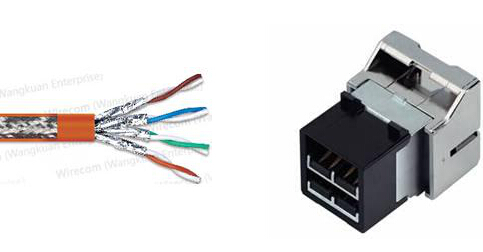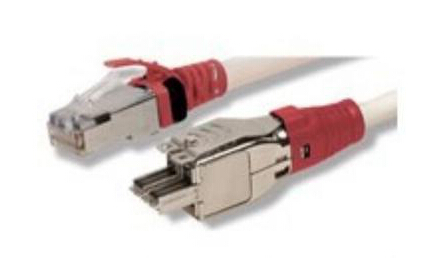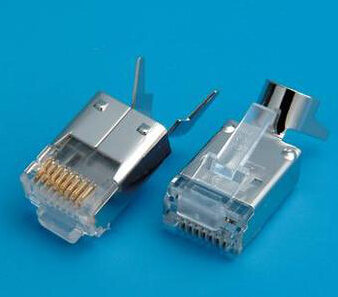The seven types of standards are a set of standards that support up to 600MHz bandwidth transmission wiring on 100-ohm twisted pairs. Category 7 wire is an 8-core shielded wire. Each pair has a shielding layer (usually a metal foil shield DINTEK), and then there is a shielding layer (usually a metal braided wire mesh shield DINTEK) outside of the 8 cores. The current RJ-45 is not compatible.

There are many significant differences between Category 7 and Category 6 cabling. The most obvious is the bandwidth. Compared with Category 4, Category 5, Category 5, and Category 6, Category 7 has a higher transmission bandwidth (at least 600 MHz), and Category 6 channels Offering at least 200 MHz of integrated attenuation-to-crosstalk ratio and overall 250 MHz of bandwidth, a Class 7 system can provide a combined attenuation-to-crosstalk ratio of at least 500 MHz and an overall bandwidth of 600 MHz. Another difference between the six and seven systems is their structure. Category 6 cabling can use either UTP or STP, while Category 7 cabling is based only on shielded cables. Each of the seven types of cables has a shield, and the four pairs of wires together have a common large shield. From the physical structure point of view, the extra shielding layer makes the seven types of wires have a larger wire diameter. There is also an important difference lies in its ability to connect hardware, the parameters of the seven types of systems require the connector to provide at least 60DB of comprehensive near-end winding at 600MHZ, and the super five systems only require 43DB at 100MHZ, Six types of data at 250MHZ are 46DB.
Comparison of seven types of cabling technology and optical fiber
The demand for bandwidth is increasing with the rapid development of network applications. This year's six-category cabling system, with its 250MHz bandwidth, meets most of the current commercial applications. However, with the continuous advancement of technology, it is only a matter of time that the 250 MHz bandwidth cannot fully satisfy people's needs.

Therefore, the discussion on the development of the cabling system in the next few years will begin with a discussion on the superiority and inferiority of the seven types of cabling and optical cables.
Select the type of cable from the use of the cable, the required transmission capacity, transmission bandwidth, price and other aspects of comprehensive consideration. There are three types of cable types: unshielded twisted pair, shielded twisted pair, and fiber optic cable.
(1) Unshielded twisted pair UTP is the most widely used cabling system in China. It is suitable for network applications with transmission bandwidth below 250MHz and no special performance requirements. Its advantages are good overall performance, low price, and convenient construction and maintenance. . Category 6 cabling systems have reached the performance limit of unshielded twisted pair.
(2) Aluminum foil shielded twisted pair FTP has a large bandwidth and strong anti-interference performance, and is characterized by low smoke and halogen free. In contrast, the shielded cable is higher than the non-shielded cable in price and installation cost, and the cable bending performance is slightly inferior. Category 6 and previous shielding systems use this form.
(3) Independently shielded twisted pair STP, each pair of wires has an aluminum foil shield, four pairs of wires together and a common metal braided shield, which is the standard structure of the seven types of wires. It is suitable for high-speed network applications, provides highly confidential transmissions, supports future new applications, and helps to unify current network application wiring platforms, enabling various information from e-mail to multimedia video to be on the same high-speed system. Transmission. The extra shielding layer makes the seven types of wires have a larger wire diameter. These characteristics require special care when designing the installation of routing and termination space, leaving a lot of space and a large bending radius. Currently, Corning has In China, a seven-category cabling system was introduced.

As early as in 1997, the standardization organization and manufacturer of cabling had proposed the concept of seven types of copper cabling systems, which can provide an integrated attenuation-to-crosstalk ratio of at least 500 MHz and an overall bandwidth of 600 MHz. The connector requires all the cables at 600 MHz. Provides a comprehensive near-end stringing of at least 60 dB. Super five systems only require 43dB at 100MHz, and 46dB for six types at 250MHz. Moreover, due to its excellent shielding design and high bandwidth, a typical Class 7 channel can even provide a pair of 862 MHz bandwidth at a time for transmitting cable TV signals, an analog audio signal on another pair, and then at the third. Four-wire transmission of high-speed local area network information. This type of application is currently unthinkable, but will soon be implemented in seven types of cabling systems. The introduction of seven types of cabling systems has led the industry to achieve a bandwidth of 1200 MHz.
Compared to fiber-optic LANs, seven types of system solutions provide the desired performance and bandwidth, but their overall cost is only a fraction of that of fiber. Some people think that the fiber optic system can bring enough bandwidth to people, and the price of fiber optic cable and seven types of cable is close. However, if the cost factors of optical fiber routers, optical switches, and optical network cards are taken into account, the price advantage of optical fibers will be quickly lost.
(4) Fiber optic cables, especially single-mode fiber optic cables, can be used for high-speed network transmission, and have the advantages of inherent immunity to electromagnetic interference, strong reliability, and support for long-distance transmission. They are ideal network transmission media in the future and their status is increasingly important. However, the cable equipment, materials, and termination costs are relatively expensive and the installation is relatively complicated, so it is generally suitable for long-distance and large-capacity wiring. At present, 62.5/125 μm multi-mode optical fiber has become the mainstream wiring medium in the integrated wiring trunk system, and its application in horizontal systems has become increasingly widespread.
The new version of TIA/EIA-568-B.3 specifies the mechanical characteristics and transmission performance of optical fibers, connection hardware, and fiber patch cables. The most significant enhancement compared to the 568-A is the recognition of 50/125 μm multimode fiber and, in addition to SC connectors, the approval of SFF fiber optic connectors as work area connectors. Allowing the use of SFF connectors brings many benefits to the end user. For example, the large size of the SC connector does not support the industrial trend of the device interface toward high density, and the use of SFF connectors makes it very easy to work with RJ-45 Two-core fiber is connected in the same space. Thanks to TIA's recognition of SFF fiber optic connectors, fiber optic equipment manufacturers such as CISCO, 3Com, and IBM have incorporated these interface designs into their products.

There are many significant differences between Category 7 and Category 6 cabling. The most obvious is the bandwidth. Compared with Category 4, Category 5, Category 5, and Category 6, Category 7 has a higher transmission bandwidth (at least 600 MHz), and Category 6 channels Offering at least 200 MHz of integrated attenuation-to-crosstalk ratio and overall 250 MHz of bandwidth, a Class 7 system can provide a combined attenuation-to-crosstalk ratio of at least 500 MHz and an overall bandwidth of 600 MHz. Another difference between the six and seven systems is their structure. Category 6 cabling can use either UTP or STP, while Category 7 cabling is based only on shielded cables. Each of the seven types of cables has a shield, and the four pairs of wires together have a common large shield. From the physical structure point of view, the extra shielding layer makes the seven types of wires have a larger wire diameter. There is also an important difference lies in its ability to connect hardware, the parameters of the seven types of systems require the connector to provide at least 60DB of comprehensive near-end winding at 600MHZ, and the super five systems only require 43DB at 100MHZ, Six types of data at 250MHZ are 46DB.
Comparison of seven types of cabling technology and optical fiber
The demand for bandwidth is increasing with the rapid development of network applications. This year's six-category cabling system, with its 250MHz bandwidth, meets most of the current commercial applications. However, with the continuous advancement of technology, it is only a matter of time that the 250 MHz bandwidth cannot fully satisfy people's needs.

Therefore, the discussion on the development of the cabling system in the next few years will begin with a discussion on the superiority and inferiority of the seven types of cabling and optical cables.
Select the type of cable from the use of the cable, the required transmission capacity, transmission bandwidth, price and other aspects of comprehensive consideration. There are three types of cable types: unshielded twisted pair, shielded twisted pair, and fiber optic cable.
(1) Unshielded twisted pair UTP is the most widely used cabling system in China. It is suitable for network applications with transmission bandwidth below 250MHz and no special performance requirements. Its advantages are good overall performance, low price, and convenient construction and maintenance. . Category 6 cabling systems have reached the performance limit of unshielded twisted pair.
(2) Aluminum foil shielded twisted pair FTP has a large bandwidth and strong anti-interference performance, and is characterized by low smoke and halogen free. In contrast, the shielded cable is higher than the non-shielded cable in price and installation cost, and the cable bending performance is slightly inferior. Category 6 and previous shielding systems use this form.
(3) Independently shielded twisted pair STP, each pair of wires has an aluminum foil shield, four pairs of wires together and a common metal braided shield, which is the standard structure of the seven types of wires. It is suitable for high-speed network applications, provides highly confidential transmissions, supports future new applications, and helps to unify current network application wiring platforms, enabling various information from e-mail to multimedia video to be on the same high-speed system. Transmission. The extra shielding layer makes the seven types of wires have a larger wire diameter. These characteristics require special care when designing the installation of routing and termination space, leaving a lot of space and a large bending radius. Currently, Corning has In China, a seven-category cabling system was introduced.

As early as in 1997, the standardization organization and manufacturer of cabling had proposed the concept of seven types of copper cabling systems, which can provide an integrated attenuation-to-crosstalk ratio of at least 500 MHz and an overall bandwidth of 600 MHz. The connector requires all the cables at 600 MHz. Provides a comprehensive near-end stringing of at least 60 dB. Super five systems only require 43dB at 100MHz, and 46dB for six types at 250MHz. Moreover, due to its excellent shielding design and high bandwidth, a typical Class 7 channel can even provide a pair of 862 MHz bandwidth at a time for transmitting cable TV signals, an analog audio signal on another pair, and then at the third. Four-wire transmission of high-speed local area network information. This type of application is currently unthinkable, but will soon be implemented in seven types of cabling systems. The introduction of seven types of cabling systems has led the industry to achieve a bandwidth of 1200 MHz.
Compared to fiber-optic LANs, seven types of system solutions provide the desired performance and bandwidth, but their overall cost is only a fraction of that of fiber. Some people think that the fiber optic system can bring enough bandwidth to people, and the price of fiber optic cable and seven types of cable is close. However, if the cost factors of optical fiber routers, optical switches, and optical network cards are taken into account, the price advantage of optical fibers will be quickly lost.
(4) Fiber optic cables, especially single-mode fiber optic cables, can be used for high-speed network transmission, and have the advantages of inherent immunity to electromagnetic interference, strong reliability, and support for long-distance transmission. They are ideal network transmission media in the future and their status is increasingly important. However, the cable equipment, materials, and termination costs are relatively expensive and the installation is relatively complicated, so it is generally suitable for long-distance and large-capacity wiring. At present, 62.5/125 μm multi-mode optical fiber has become the mainstream wiring medium in the integrated wiring trunk system, and its application in horizontal systems has become increasingly widespread.
The new version of TIA/EIA-568-B.3 specifies the mechanical characteristics and transmission performance of optical fibers, connection hardware, and fiber patch cables. The most significant enhancement compared to the 568-A is the recognition of 50/125 μm multimode fiber and, in addition to SC connectors, the approval of SFF fiber optic connectors as work area connectors. Allowing the use of SFF connectors brings many benefits to the end user. For example, the large size of the SC connector does not support the industrial trend of the device interface toward high density, and the use of SFF connectors makes it very easy to work with RJ-45 Two-core fiber is connected in the same space. Thanks to TIA's recognition of SFF fiber optic connectors, fiber optic equipment manufacturers such as CISCO, 3Com, and IBM have incorporated these interface designs into their products.
bbq grill, bbq grill mesh, Grill Grate, stainless wire bbq grill,Bbq Grill Metal Mesh,etc. It is suitable for indoor and outdoor barbecue.
Barbecue wire grill grate is made of high quality 304 stainless steel, never rusting and durable. BBQ Wire mesh does not have any coating or chemical ingredients, making food safer.
Barbecue wire grill grate is made of high quality 304 stainless steel, never rusting and durable. BBQ Wire mesh does not have any coating or chemical ingredients, making food safer.
bbq grill mesh,stainless wire bbq grill,Bbq Grill Metal Mesh,cooking grate,bbq grill grates stainless steel
Shenzhen Lanejoy Technology Co.,LTD , http://www.grill-mesh.com